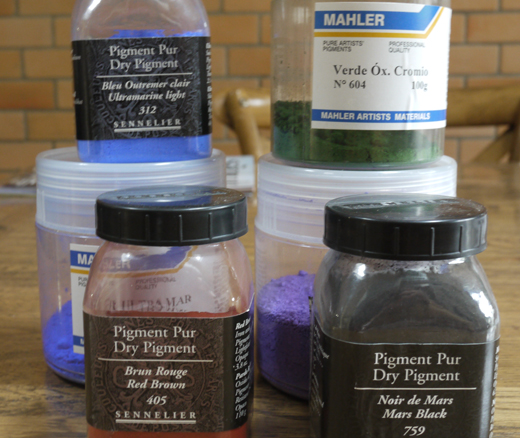Three features should be considered in the choice of materials to give color to soaps made by cold process. The coloring materials must first be inert to the skin, i.e. must not cause any adverse reactions in contact with the skin. Must be resistant to alkaline saponification reaction of the cold process and should be light resistant, must not fade and lose the color when the soap is exposed to light.
To meet the first requirement, the best option is to use materials approved by the FDA (Food and Drug Administration) U.S. for use in cosmetics. Combining this with the others requirements, there are few alternatives and usually fall in the class of pigments, most inorganic and synthetic.
• Iron oxide – black, red, yellow, ocher
• Ultramarine – dark blue, light blue and violet
• Chrome oxide – light green and dark green
• Titanium dioxide – white
• Zinc oxide – white, light red (calamine)
• Ferric Ferrocyanide – Dark Blue
• Mica – pearlescent effect of various hues
These class of pigments are those approved by the FDA are resistant to cold process and will not fading with time.
These pigments are hard to be found in small quantities that are used in soapmaking. An alternative that I use is to buy these pigments in shops selling art materials – the painters use to prepare their paints. They are sold in small packages, less than 100g, costly but yield much but you can buy sharing with other crafters. I use of trademarks Sennelier (French) and Mahler (fractionated in Brazil).
Besides these pigments can be used clays that have no tinting strenght as pigments but are easy to be found in the colors white, green, yellow and pink, these two latter mixed in its preparation, with iron oxide. For black color option you can use of bamboo charcoal that besides the strong tinting strength has its skin conditioning properties.
Another option is to do your own coloring, by maceration of certain plants with oils that are commonly used in cold process. An example is the macerating green tea or herbal mate to obtain a light green color. Some components of the formulation itself may give a slight color to your soap, as the honey will give you a cream or the use of goat milk that depending on the cold process temperature can give a cream or dark brown or ocher.
Important to emphasize that most dyes which are used in food and coloring candles are anilines (azo components) that are not resistant to alkali and also has not resistance to light and hence should not be used to impart color to the soap. In this case it is always good to test before.
A final observation concerns the question of natural versus synthetic pigments. If you are a nattural soapmaking and waives only use materials of natural origin, it is understandable that you will not use a synthetic pigment (man-made). Turns out the FDA approval only synthetic pigments because the natural may be contaminated with heavy metals (toxic) that can not be separated in their extraction and actually do some harm to health, such as lead and cadmium. The choice is yours!
On the download page I put files with a list of materials approved by the FDA for use in cosmetics and also the catalog of artistic Sennelier pigments. In both are marked pigments that can be used in cold process.





